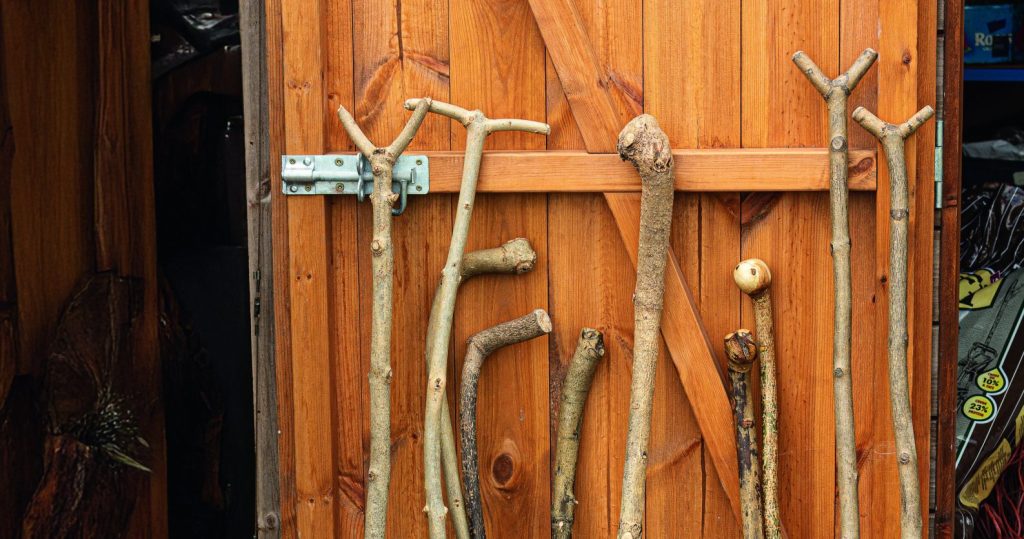Win CENS ProFlex DX5 earplugs worth £1,149 – enter here
The benefits of using a quiet air rifle for pest control
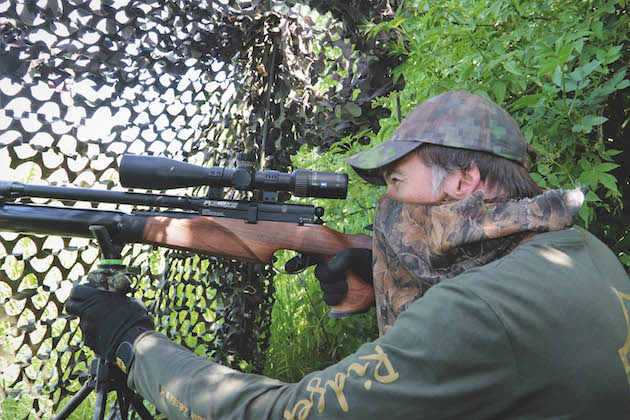 Another crow swoops in and Mat lines up a shot from his shady hiding place.
Another crow swoops in and Mat lines up a shot from his shady hiding place.
While I’m the first to admit that a shotgun is usually the best option for controlling corvids over open ground, there are plenty of times when using an airgun for pest control is a more appropriate choice. The former will usually help you to make the necessary big bags when crows and rooks are descending on seed drills, but the latter will always win out when you need to take a more discreet approach. So this piece is all about the benefits of using a quiet air rifle for pest control.
Over the past couple of weeks, I have been helping a farmer friend to thin out the hordes of crows and jackdaws that have been raiding his silage heaps. Though he has covered this valuable feed as best he can, the scavenging corvids are relentless and have still been flocking to the end that is usually left open for machines to access. Apart from physically diminishing the maize silage, the birds also pose a health risk, and the silage clamps and the area around them are caked in white droppings.
My initial outings with the shotgun yielded a couple of 60-plus bags but, with farm workers, buildings and livestock to consider, I couldn’t set up too close to the yard. Even with strategically positioned flags in place, there were always a few artful birds that ignored my decoys, passed by out of range and settled on the silage.
Using a quiet air rifle for pest control
I vowed to teach them a lesson and a stealthy approach with a quiet air rifle for pest control seemed the best way to do it. Though my previous visits had started to reduce the number of corvids targeting the holding, there were a dozen or so around the silage clamps when I arrived for my airgun foray. These are educated birds and they didn’t hang around for long once I started lugging my kit out of the car.
Crafty corvids
Outwitting crafty pests that have seen a bit of shooting pressure can be challenging, especially when you need them to land within striking distance of an air rifle. Fortunately for me, there is a rough area of scrubby ground down one side of the silage heaps and it’s flanked by a hedge that provided some useful cover a very convenient 30m from my intended target zone. The field drops down to a ledge that offers a flat area about 6ft wide before it falls away into the ditch — this plateau gave me a level area to set up with the hedge over the top of me, offering cover from sharp-eyed birds and shade from the searing hot sun.
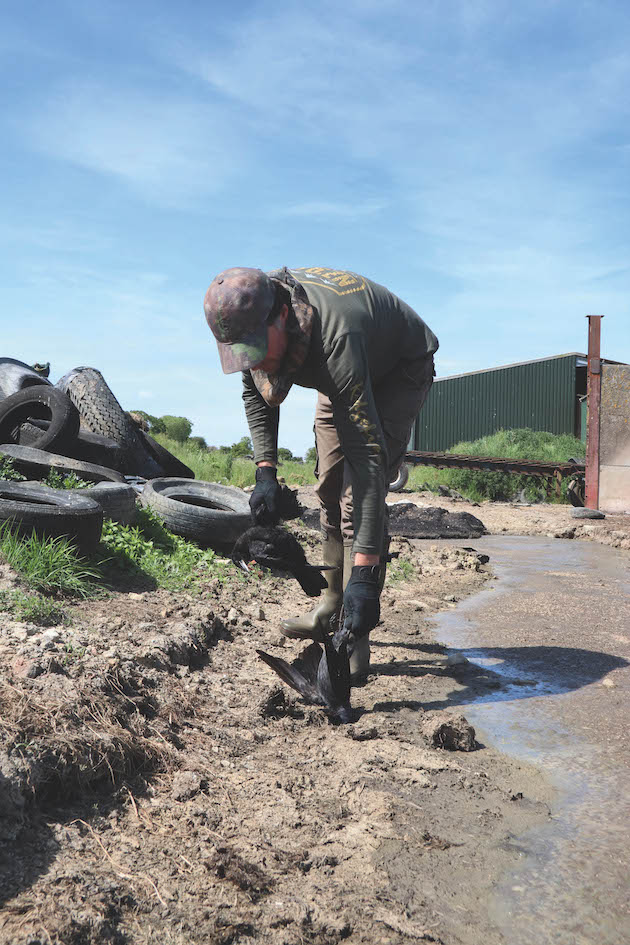
Mat breaks cover to tidy up the shot birds after incomers start to spook on their approach.
Not wanting to draw too much attention to myself, I quickly threw up a very basic hide comprising a couple of nets. I didn’t even bother dressing them with vegetation — the hedge and my low position made for a very discreet hide site and I didn’t want to hang around in full view for any longer than I had to.
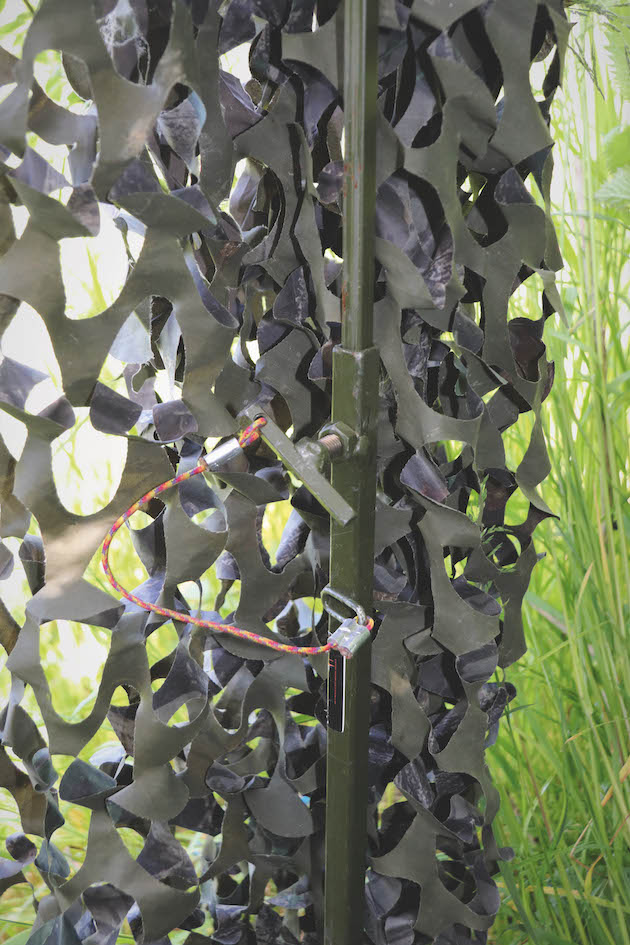
Sniper Hide Poles have several handy features, including ties to stop you from losing the height-adjuster screws.
Setting up a hide
About six months ago, I got a set of Sniper hide poles from Nick Tait at Flightline, and they help when it comes to a quick setup. They have a neat little hook to fasten the bottom of the net, so you don’t have to go rummaging for pegs to stop it flapping in the wind. The fact that the height-adjuster screws are actually fastened to the poles is a real asset for people like me who have a knack for losing small but essential components. They are a bit heavier than the flimsier poles that most of us are used to, but they are very ruggedly constructed and should give years of good service.
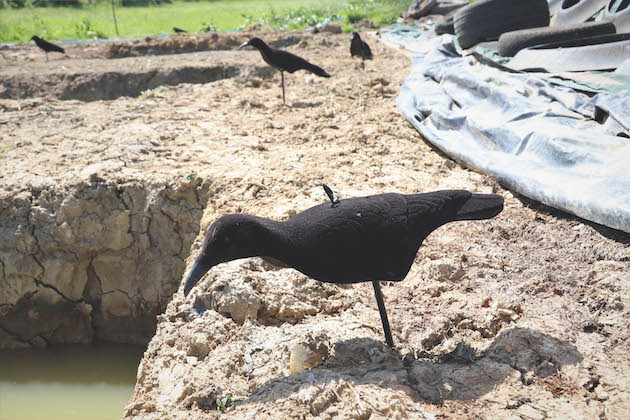
A scattering of shell and full-body decoys was used to persuade the corvids that it was safe to return to their feeding ground.
Back to the crows, and my next job was to set out some decoys to persuade them that it was safe to return. I like to use a few full-bodied decoys for realism, but most of my fake flock is made up of shells because they are lighter and easier to carry. I soon had about a dozen set up around the edge of the silage heap and was surprised by how convincing they looked when viewed from above.
A quiet air rifle for pest control – the BSA R-10 TH
Tucked away in the hide and comfortably perched on my bucket seat, I loaded up my BSA R-10 TH ready for the return of the birds. This gun is a flat-shooting .177 and, being a sub-12ft/lb model, lends itself well to shooting close to buildings and livestock. The fact that it is remarkably quiet is also a real boon, both in terms of stealth and reducing disturbance. (For advice on the best air rifle pellets read here.)
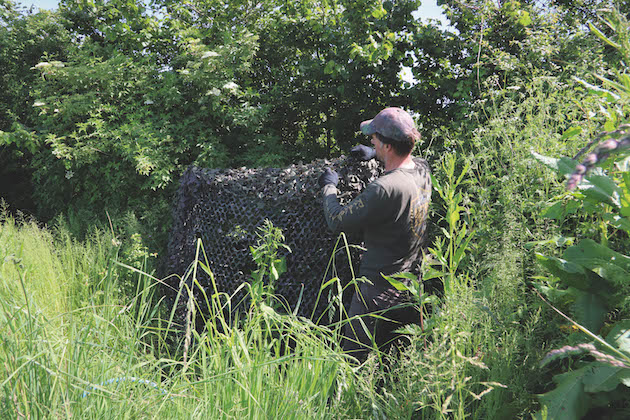
Mat set up his hide on a ledge below the level of the field and tucked into the hedge.
I have recently paired this gun with a Zeiss Conquest V4 telescopic sight. I hadn’t really regarded Zeiss as an airgun optics brand until I heard that this range had been redesigned to parallax down to 10 yards, and I’m glad it took the trouble. It’s not a cheap scope, but its price tag is certainly justified by its remarkable optical quality.
It wasn’t long before the new glass was pressed into service as a young crow circled overhead and pitched on the wall on my side of the silage clamp. Clearly distracted by the decoys, the gullible youngster failed to notice me slipping the BSA’s muzzle through the net and I toppled it cleanly from its perch with a pellet to the head.
Three jackdaws and a crow followed over the next half an hour then things went very quiet. Birds were still passing over from time to time, but they wouldn’t commit to landing. I guessed that they were probably spooked by the bodies 3of their fallen comrades, so I broke cover for a quick tidy-up.
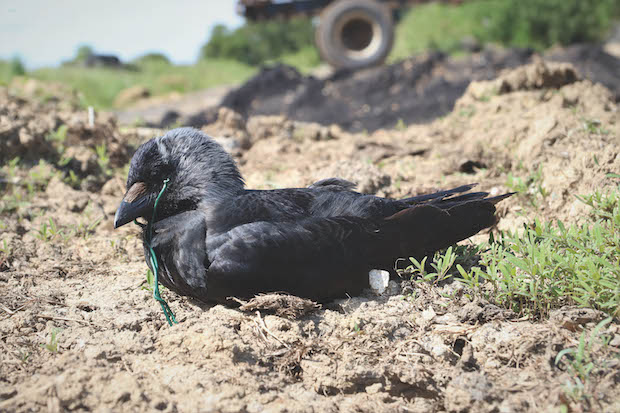
Lengths of stiff garden wire were twisted to create simple props to turn shot birds into convincing decoys.
Dead birds can really boost the attraction of a decoy pattern, so I added them to the scene I had created with the artificials. I always keep a few lengths of stiff garden wire in my decoy bag for this task. By folding a 30cm length in half and twisting it up to increase its stiffness and leaving the two ends to create a small fork, you can make a simple prop to push into the ground and support the heads of dead birds to make them look more lifelike.
Hectic
Later action was never as hectic as the first half-hour, but the birds did make a return. It needed a patient approach, and not being able to jump up and take on flying birds as they crossed past was frustrating after my outings with the shotgun, but I added three more crows and another three jackdaws before I hauled myself out for another clear-up.
There was hardly a cloud in the sky and I was very grateful for the shade provided by the hedge as the sun climbed higher and the temperature rose with it. I don’t think I would have been able to tolerate it for much longer than an hour in a more exposed position, but four hours had passed before I decided to call time.
My final tally was nine crows and eight jackdaws. While I don’t doubt that I would have made a bigger bag with the shotgun, I like to think the more subtle approach of using a quiet air rifle for pest control enabled me to account for a few that might otherwise have slipped in under the radar if I’d been in my usual position further from the yard.
Related Articles
Get the latest news delivered direct to your door
Subscribe to Shooting Times & Country
Discover the ultimate companion for field sports enthusiasts with Shooting Times & Country Magazine, the UK’s leading weekly publication that has been at the forefront of shooting culture since 1882. Subscribers gain access to expert tips, comprehensive gear reviews, seasonal advice and a vibrant community of like-minded shooters.
Save on shop price when you subscribe with weekly issues featuring in-depth articles on gundog training, exclusive member offers and access to the digital back issue library. A Shooting Times & Country subscription is more than a magazine, don’t just read about the countryside; immerse yourself in its most authoritative and engaging publication.







